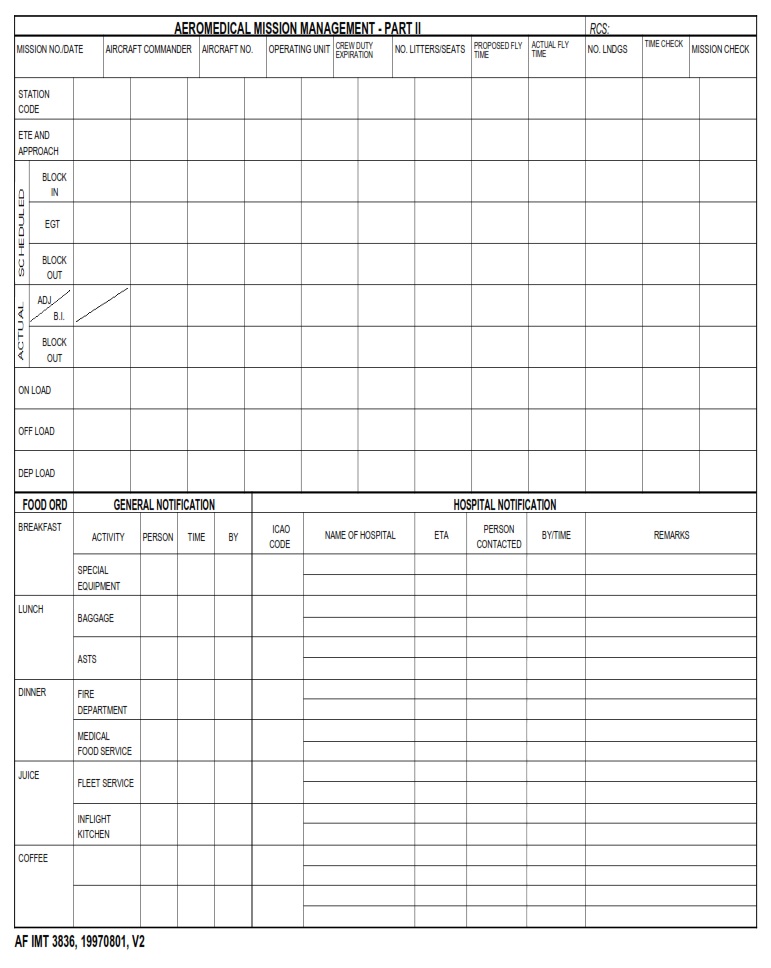AF-FORMS.COM – AF Form 3836 – Aeromedical Mission Management – Part II – Welcome to the second part of our exploration into the intricacies of Aeromedical Mission Management with AF Form 3836. In Part II, we delve deeper into the vital role this form plays in ensuring the safety and success of aeromedical missions. From coordinating patient care to managing flight logistics, AF Form 3836 is a crucial tool for aircrew members and medical personnel alike. So buckle up as we take you on a journey through the fascinating world of aeromedical mission management and uncover how this form is essential for delivering life-saving care in high-stakes environments.
Embark on an exhilarating adventure as we unravel the complexities of AF Form 3836 – Aeromedical Mission Management in Part II of our series. Join us as we explore how this form facilitates seamless coordination between medical teams, aircrew, and ground support personnel to overcome challenges unique to aeromedical missions.With its meticulous attention to detail and emphasis on risk assessment, AF Form 3836 stands as a testament to the dedication and precision required for successful aeromedical operations. So get ready to be captivated by the critical role this form plays in ensuring that every flight is not just a mission but a lifeline for those in need.
Download AF Form 3836 – Aeromedical Mission Management – Part
| Form Number | AF Form 3836 |
| Form Title | Aeromedical Mission Management – Part II |
| Edition Date | 8/1/1997 |
| File Size | 38 KB |
What is an AF Form 3836?
The AF Form 3836 is a critical document within the Aeromedical Evacuation community, serving as a comprehensive record of patient care and mission management. With its detailed sections for medical assessment, treatment interventions, and vital sign recordings, this form ensures that all necessary information is carefully documented for the safety and welfare of patients during air transport. Additionally, the form includes space for documenting crew observations and recommendations, creating an essential communication tool between medical personnel and flight crews.
Moreover, the AF Form 3836 plays a crucial role in ensuring continuity of care across multiple medical facilities. By accurately capturing patient status at various stages of air transport, this form enables receiving healthcare providers to understand the patient’s condition throughout their journey. This level of thorough documentation enhances patient safety and supports effective decision-making by medical teams at both ends of the aeromedical evacuation process. As such, the AF Form 3836 stands as a testament to the dedication of military medical professionals to deliver exceptional care even under challenging circumstances.
Where Can I Find an AF Form 3836?
If you’re on the hunt for an AF Form 3836, you’ll be pleased to know that this essential document can typically be found at your local military installation, medical treatment facility, or aeromedical evacuation squadron. Additionally, many forms and documents are increasingly being digitized and made accessible online through official Air Force portals. This shift toward digital access has streamlined the process of locating and obtaining necessary forms, including the AF Form 3836.
For those with digital accessibility in mind, it’s also worth noting that certain third-party websites may offer a download option for various military forms. However, it’s crucial to exercise caution and ensure that any form obtained from such sources is indeed current and officially sanctioned. Whether seeking a physical copy at a military facility or opting for the convenience of downloading online, rest assured that securing an AF Form 3836 is well within reach for those navigating aeromedical mission management within the U.S. Air Force.
AF Form 3836 – Aeromedical Mission Management – Part II
In Part II of the AF Form 3836 – Aeromedical Mission Management, we delve deeper into the critical aspects of ensuring the safety and efficiency of aeromedical missions. This form plays a pivotal role in streamlining communication and coordination among all stakeholders involved in such missions. From flight surgeons to crew members, each individual’s responsibilities and medical considerations are carefully documented to ensure a seamless operation.
Furthermore, Part II emphasizes the need for meticulous planning and contingency measures. By outlining specific medical requirements, potential risks, and available resources, this form ensures that every possible scenario is accounted for. This level of detail not only enhances the overall effectiveness of aeromedical missions but also reflects the Air Force’s unwavering commitment to prioritizing personnel welfare.
Overall, Part II of AF Form 3836 sheds light on the intricate nature of aeromedical mission management and underscores the meticulous approach required to execute these vital tasks successfully. It serves as a testament to the dedication and expertise invested in safeguarding both military personnel and civilians during critical airborne medical operations.
